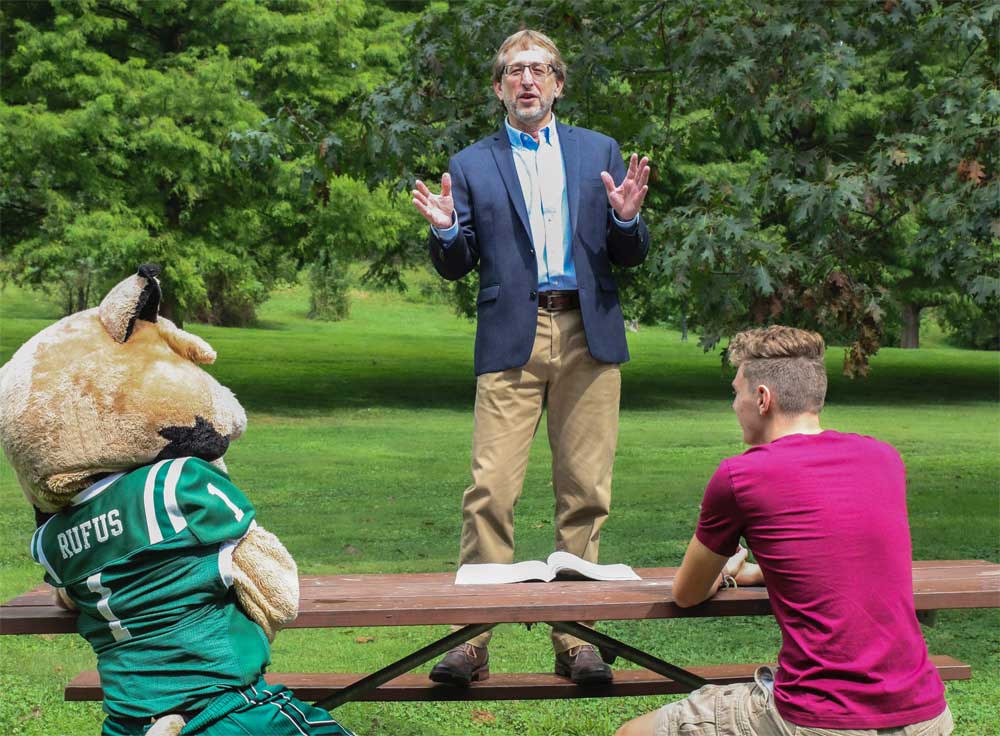Students in Mark Shatz’s general psychology class can be sure of one thing as they prepare to take his multiple-choice exams: Choice “E” is never the correct answer.
From the moment students enter his classroom and receive his syllabus—salted with references to Yoda, Judge Judy, and “The Simpsons”—through the last day of class and the final exam—where choice “E” is always a joke—Shatz infuses humor as a tool to build relationships that facilitate learning.
“I view humor as an educational and social lubricant,” explains Shatz, professor emeritus of psychology at Ohio University Zanesville. “When used properly, it enhances connections—to people, material, and places.”
Shatz was a brave professor who took—and aced—the late OHIO faculty member Mel Helitzer’s class, “Humor Writing for Fun and Profit,” known for its intimidating final exam: a five-minute stand-up comedy performance before a live audience.
Shatz went on to emcee the course’s final, teach the class at the Zanesville Campus, and co-author the second and author the third editions of Helitzer’s top-selling book, Comedy Writing Secrets . Today, and because of Helitzer’s influence, Shatz is an expert on the systematic use of humor in the classroom and infuses comedy into his body of work in educational psychology.
Shatz says relationships that take place in an educational setting come in three forms and enhance the learning process: student-to-student, student-to-teacher, and, most importantly, student-to-material.
“If you build the first two conditions—you build a sense of community and you make the teacher accessible—then it makes it so much easier to teach students the material and connect them to it,” Shatz says. “One of the ways I facilitate those connections is through the use of humor.”

Shatz’s knack for making his course material come alive is rooted in his deliberate use of humor in the classroom. Photo by Ellee Achten, BSJ ’14, MA ’17
Shatz has a refined and nuanced view of humor. It isn’t so much about jokes—although jokes, typically at his own expense, occur inside his classroom. Instead, humor is about fun, making the instruction more interactive, interesting and memorable.
“When you use humor, you’re more likely to get people to show up to class. You’re more likely to get people to pay attention and participate,” he says. “You create the experience, and you can increase the likelihood that learning is going to occur.”
Shatz views humor as an invitation, bridging the student-teacher gap, allowing for interactive instruction that brings lessons learned to life, and encouraging the belief that learning is fun.
The inviting and fun nature of humor plays particularly well at Ohio University, he says.
“I invite students, in part, in the classroom by using humor,” Shatz says. “I think Ohio University, and Athens in particular, does it by being unpretentious. When you walk onto campus, it invites you in. When you stand at Court and Union, you feel enclosed. You feel invited. That’s what makes OU, OU. It invites people to have a relationship—with the area, with the University, within their field of study, and so forth.”
Feature photograph: Mark Shatz and his son, Ethan Shatz, a first year, take a swing with Rufus as he studies the finer points of psychology. Photo by Ellee Achten, BSJ ’14, MA ’17




